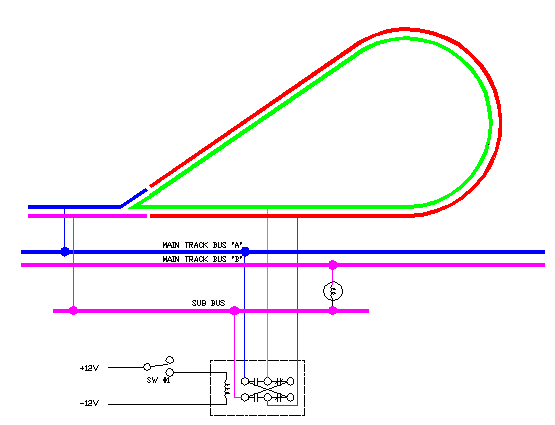Reverse loop wiring presents an interesting challenge in model
railroading. You don't encounter any problems when wiring reverse loop
for DCC in N scale or any scale.
There are many reverse loop modules/switches that are available and easy to use on a DCC layout in N scale or any scale.
The module/switch consists of four wires that require connections. Two
wires are connected to your track before a train enters the reverse
loop. The remaining two wires are connected to the rails inside the
reverse loop. The reverse loop must be
isolated from the rest of the layout by using plastic rail joiners.
You cannot use Reverse Loop Modules/Switches for wiring reverse loops in
DC systems. There are many Reverse Loop Modules/Switches that can be
used for reverse loops in DCC layouts.
The Reverse Loop Module/Switch automatically changes the polarity of the rails when a train enters and leaves the reverse loop.
You can also wire a block occupancy detector inside the reverse loop if your layout uses block occupancy detection.
Dog bones, Wyes and Turntable also need Reverse Loop Modules in DCC N scale layouts as well as any other scales.
The most important rule to follow for reverse loops is
that the train in the reverse loop must be shorter than the reverse loop itself if that train has metal wheel sets or lights.. If the length of the train is longer than the reverse loop a short circuit will occur.
In N scale most rolling stock of trains come equipped with plastic wheel
sets. If the plastic wheel sets are changed over to metal wheel sets
then this rule must be followed.
Each reverse loop requires its own Reverses Loop Module/Switch.If you
use one Reverse loop Module/Switch to control more than one reverse
loop, at some point you're going to short out your system when two
trains enter reverse loops controlled by one Reverse Loop Module/Switch
at the same time.
The "original" JJJ&E had four reverse loops and one turntable. Each
reverse loop was controlled automatically by its own Reverse Loop
Module/Switch.
So, if a track plan has more than one reverse loop and you're using DCC,
don't feel that the wiring is too difficult to do. The Revere loop
Module/Switch solves the wiring problem easily.
Reverse loops provide some very interesting train operations and the
operator of a layout with reverse loops can't put the trains operating
on such a layout
on auto pilot.
Have fun wiring reverse loops with Reverse Loop Modules/Switches. When
you run trains through these reverse loops, you'll notice no change in
the trains momentum as they glide through the reverse loops.























